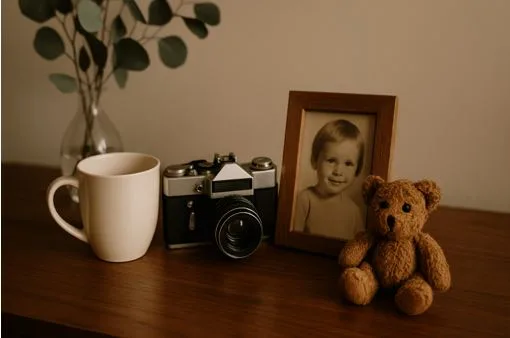Finding Meaning In Everyday Home Objects
Have you ever wondered how the objects in your home can hold deep personal meaning? Your surroundings play a crucial role in shaping your emotions and memories. From family heirlooms to souvenirs from memorable trips, these everyday items serve as anchors to our experiences, evoking powerful emotions and nostalgia.
Creating a meaningful home environment can be challenging, but this article will guide you through the process. We’ll explore how to:
✔️ Recognize the emotional value of common items
✔️ Understand how ordinary objects influence our daily mindset
✔️ Uncover unseen stories and memories tied to household things
Let’s discover how to transform your living space into a treasure trove of personal significance and emotional connection.
Understanding The Significance Of Daily Surroundings
How Ordinary Objects Influence Our Daily Mindset
Your environment plays a crucial role in shaping your mood and behavior. The objects you interact with daily have a subtle yet profound impact on your mindset.
Research in environmental psychology suggests that our surroundings can significantly affect our cognitive processes and emotional states. For example, a tidy desk might promote focus and productivity, while a cluttered space could lead to feelings of stress or overwhelm.
Colors, textures, and shapes in your environment can also influence your mood. Soft, warm tones might create a sense of comfort, while bright, vibrant colors could energize you. The presence of plants, candles from SOJA&CO. or natural elements can reduce stress and improve overall well-being.
Even the smallest objects can make a difference. A motivational quote on your wall might boost your confidence, while a family photo on your desk could provide a moment of joy during a busy workday.
By becoming aware of how these ordinary objects affect you, you can intentionally curate your space to support your desired mindset and emotional state.
How Ordinary Objects Influence Our Daily Mindset
Your environment plays a crucial role in shaping your mood and behavior. The objects you interact with daily have a subtle yet profound impact on your mindset.
Research in environmental psychology suggests that our surroundings can significantly affect our cognitive processes and emotional states. For example, a tidy desk might promote focus and productivity, while a cluttered space could lead to feelings of stress or overwhelm.
Colors, textures, and shapes in your environment can also influence your mood. Soft, warm tones might create a sense of comfort, while bright, vibrant colors could energize you. The presence of plants or natural elements can reduce stress and improve overall well-being.
Even the smallest objects can make a difference. A motivational quote on your wall might boost your confidence, while a family photo on your desk could provide a moment of joy during a busy workday.
By becoming aware of how these ordinary objects affect you, you can intentionally curate your space to support your desired mindset and emotional state.
Exploring Personal Connections and Nostalgia
Identifying Objects With Sentimental Backgrounds
Take a moment to look around your home. Which items catch your eye and make you smile? These might have sentimental value. To identify these special objects, reflect on your personal history. Think about gifts from loved ones, family heirlooms, or souvenirs from memorable trips.
Consider items that remind you of significant life events or achievements.
Ask yourself: What emotions does this object evoke? Does it connect you to a specific person or time in your life? Objects with sentimental value often tell a story or represent a cherished memory. They might not be the most expensive or visually striking things you own, but they hold deep personal meaning.
Reviving Childhood Memories Through Familiar Items
Certain objects have the power to transport us back to our childhood. A favorite toy, a well-worn book, or even a particular scent can trigger vivid memories from years ago. This phenomenon occurs because our brains form strong connections between sensory experiences and emotions during our formative years.
Common nostalgia-inducing items include:
- Old photographs
- Childhood toys or games
- School yearbooks
- Family recipes
- Music from your youth
These objects act as memory cues, activating neural pathways associated with past experiences. When you encounter them, your brain retrichemicals like dopamine, creating a pleasant, nostalgic feeling.
Techniques for Imbuing Artwork With Nostalgic Elements
As an artist, you can incorporate nostalgic elements into your work to create deeper emotional connections with viewers. Here are some techniques to try:
- Use warm, muted colors to evoke a sense of the past.
- Incorporate textures that mimic aged or weathered surfaces.
- Include symbolic objects that represent specific time periods or shared cultural experiences.
- Draw inspiration from vintage photographs or advertisements.
- Blend contemporary retro styles to create a timeless feel.
Remember, drawing items with personal significance adds depth and sentiment to your artwork. By depicting everyday objects that hold meaning for you, you can infuse your creations with genuine emotion and make the artistic process more meaningful.
Fostering Mindfulness Through Observation
Slowing Down To Notice Details
Have you ever taken a moment to truly observe your? Practicing mindfulness by paying attention to details in your surroundings can be a powerful way to enhance your daily life.
Try this simple exercise: Choose an object in your immediate environment and spend five minutes examining it closely. Notice its shape, texture, color, and any unique features. This practice helps you slow down and become more present in the moment.
Artists often use drawing as a technique to sharpen their observational skills. By sketching everyday items, they train themselves to see the world with fresh eyes. You don’t need to be an artist to benefit from this approach. Carry a small notebook and pencil with you and try quick sketches of objects you encounter throughout your day.
The Role Of Reflection And Perspective In Daily Routines
Incorporating reflection into your daily routine can significantly boost your mindfulness and appreciation for life. Set aside a few minutes each day to think about your experiences and surroundings. Ask yourself questions like: What did I notice today that I usually overlook? How did my environment affect my mood or thoughts?
Changing your perspective can also enhance your daily routines. Try looking at familiar spaces from different angles or heights. This simple shift can reveal new details and foster a sense of curiosity about your environment.
Creativity Boosts From Focused Observation
Focused observation can be a powerful tool for enhancing creativity. Many innovative ideas have sprung from careful attention to everyday objects and situations. For example, the invention of Velcro was inspired by the way burrs stuck to a dog’s fur during a walk in the woods.
Finding beauty in mundane objects encourages creativity and appreciation for small details. Challenge yourself to find something interesting or beautiful in objects you typically ignore. This practice can spark new ideas and inspire creative thinking in various aspects of your life.
Incorporating Meaningful Practices Into Everyday Life
Creating A Home Environment That Sparks Inspiration
Your home should be a place that ignites your creativity and fuels your imagination. To achieve this, start by surrounding yourself with objects that hold special meaning to you. Display artwork that moves you, or showcase travel souvenirs that remind you of cherished experiences.
Consider creating a dedicated inspiration corner in your living space. This area can feature a vision board, a collection of inspiring quotes, or a rotating display of your favorite books. By having these elements visible, you’ll constantly be reminded of your goals and passions.
Color can play a significant role in sparking inspiration. Choose hues that energize and motivate you. For some, this might mean bright, vibrant colors, while others may find inspiration in calming, neutral tones. The key is to select colors that resonate with you personally.
Don’t forget the power of nature in fostering creativity. Bring the outdoors inside with potted plants or a small indoor garden. Natural elements can help create a sense of calm and connection, which often leads to increased inspiration.
Building Rituals Around Cherished Items
Rituals can transform ordinary objects into powerful symbols of meaning and intention. By incorporating cherished items into daily routines, you can create moments of reflection and gratitude throughout your day.
For example, you might start each morning by holding a special stone or crystal while setting intentions for the day ahead. This simple act can help center your thoughts and set a positive tone for the hours to come.
Another idea is to create a weekly ritual around a family heirloom. Perhaps you have a vintage teapot passed down through generations. You could use it every Sunday evening for a special tea ceremony, taking time to reflect on your family history and connections.
Photos can also be the focus of meaningful rituals. Try selecting a different framed photo each week to place in a prominent spot. Take a moment each day to look at the image and recall the memory associated with it. This practice can help keep important relationships and experiences at the forefront of your mind.
Going Beyond Decoration: Functional Yet Sentimental
Your home should be both practical and meaningful. Look for ways to incorporate sentimental items into functional aspects of your decor. This approach ensures that cherished objects aren’t just gathering dust but are actively contributing to your daily life.
For instance, a quilt made by your grandmother could be displayed as a cozy throw on your living room couch. This not only adds warmth to the room but also keeps a family heirloom in regular use and view.
Consider repurposing sentimental items for new functions. An old ladder from your family farm could become a unique bookshelf, or vintage suitcases could serve as stylish storage solutions. These creative adaptations honor the past while meeting present needs.
When selecting new items for your home, prioritize pieces that serve a purpose and resonate with your personal style. A beautifully crafted ceramic bowl, for example, can be both a functional serving dish and a piece of art that brings you joy every time you use it.
By thoughtfully blending function and sentiment in your home decor, you create a space that not only meets your practical needs but also continually reminds you of what matters most in your life.
Frequently Asked Questions About Finding Meaning In Everyday Home Objects
How Do I Identify Which Items Hold Personal Meaning?
Start by looking around your home with fresh eyes. Ask yourself: Which objects spark memories or emotions? What items do you use daily? Consider the stories behind each piece. Reflect on gifts from loved ones or souvenirs from special trips. Think about objects that represent your values or aspirations.
Pay attention to items you’d rescue in an emergency. These questions will help uncover the hidden significance of your everyday possessions.
Can Drawing Everyday Objects Really Reduce Stress?
Yes, sketching common items can indeed lower stress levels. This practice encourages mindfulness, focusing your attention on the present moment. As you observe and recreate shapes, textures, and shadows, your mind quiets, pushing away worries.
Research suggests that engaging in creative activities like drawing activates the reward center in your brain, releasing feel-good chemicals. Many find this process meditative, providing a much-needed break from daily pressures.
What Are Simple Ways To Observe Objects More Mindfully?
Try picking up an object and examining it closely for a full minute. Notice its weight, texture, and temperature. Explore its contours with your fingers. Sketch its outline without looking at your paper. Photograph it from unusual angles. Describe it in detail to someone else.
These exercises train your brain to notice details you might typically overlook, enhancing your appreciation for everyday items.




